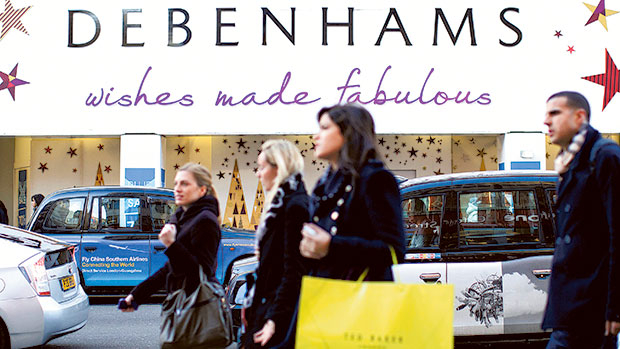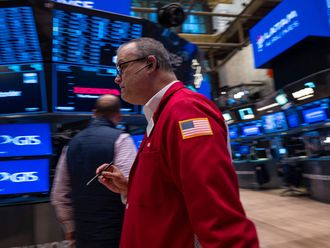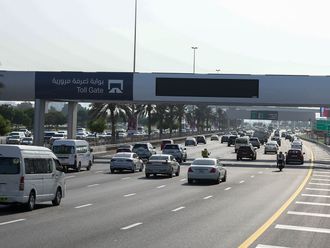
London: Kate Moss brought London's Oxford Street to a standstill in 2007 when the supermodel posed at Topshop's flagship store to launch her clothing collection.
Hundreds of shoppers lined Europe's busiest retail street, trying to get their hands on the Moss range in the 90,000 square-foot (8,300 square meters) emporium, a retail sensation buzzing with a mix of clothing, food stalls and live DJ tunes.
Now the music has stopped and Oxford Street is once again at a standstill. Topshop closed its doors in January, possibly for good, relegated to an online-only presence under a new owner. A short stroll down the street, Debenhams, a department store with more than 200 years of history, is also shuttered, as are dozens of other shops. In total, at least a fifth of the stores on Oxford Street are now shut and will not reopen after the Covid lockdown ends, according to the New West End Company, a lobby group for the district.
As UK Chancellor Rishi Sunak prepares to unveil a budget next week that retailers hope will bring more aid for a sector on its knees, Oxford Street's reputation as Europe's premier shopping destination faces its biggest threat in decades. A flood of store closures and deterioration in the quality of the buildings and public space along the near two-kilometer (1.2 miles) thoroughfare is being aggravated by lockdown restrictions that are decimating foot traffic and driving more shoppers online.
"I am really worried about the West End, there is nobody there, no shops are open and there is no reason to go," said Brian Duffy, the chief executive officer of Watches of Switzerland Group Plc, which sells fine watches and jewelery in shops on Oxford Street and the nearby Bond and Regent streets.
Steep hill
In a bid to stop the rot, the local authority for the U.K. capital's West End unveiled plans to "reinvent" the nation's main street, including a proposal to erect a climbable hill overlooking the Marble Arch landmark. The council is injecting 150 million pounds ($208 million) to kickstart the makeover, which includes a plan for more pedestrian space, pop-up parks and a wider range of businesses to reduce the reliance on retail.
Melvyn Caplan, deputy leader of the Westminster council, is optimistic the proposals will help unwind some of the issues that plagued Oxford Street long before the pandemic. The street has been taken over by a mishmash of faceless retail brands and downmarket tourist traps; noisy traffic, few public spaces to relax and a lack of entertainment activities further diminished its appeal.
"Oxford Street used to be at the heart of London's culture but it has disappeared a bit behind all the retail," Caplan said.
The demise of London's top shopping destination is emblematic of major cities struggling to reinvent their main retail spheres. In Berlin, the Kurfuerstendamm long suffered a hemorrhaging of shoppers who favored smaller boutiques in the fashionable eastern part of the city or gravitated online. Only recently has the street made a comeback with a blend of restaurants, high-end boutiques and bread-and-and butter fashion retailers.
In Paris, the Champs Elysee avenue is trying to revert years of decline with a $305 million plan that pares back the space allotted to cars, increases the area's tree cover and seeks to encourage more small-scale shops along the avenue's flanks.
"The Parisians have certainly got their act together," said Jace Tyrell, chief executive officer of New West End Company. "We don't want to lose out to our great rival."
Crown estate
The council doesn't even need to look as far as Paris to learn how a concerted effort can reimagine a fading street.
At the turn of the millennium, the Crown Estate, the property company that generates income for Queen Elizabeth II, began a regeneration of nearby Regent Street and the Piccadilly Circus area after it became an uninspiring sea of travel agents and tourist shops flogging Union-Jack memorabilia.
Today, the street houses flagship stores of global brands including Apple Inc. and Burberry Group Plc. Since the pandemic began, the Crown Estate has also widened sidewalks and introduced new greenery and seating areas.
The revamp was made easier by the consolidated ownership of properties on Regent Street, said James Cooksey, director of central London development at the Crown Estate. It's a bonus that Oxford Street doesn't have, given properties there are in the hands of multiple landlords, complicating a concerted regeneration effort.
Still, with the council pouring resources into the revival, more landlords pulling together and the general public rearing to go shopping again after months of being stuck at home, Oxford Street, too, has a chance to turn itself around, Cooksey said.
Westminster's revival plans may get an additional boost from short-term measures in next week's budget, such as an extension of furlough, an employment-support program, and relief from a U.K. property tax that's a heavy burden for many retailers. Such a move would be particularly welcomed by retailers after the Treasury abolished tax-free shopping for overseas visitors, which dealt a crushing blow to West End retail.
Overseas shoppers
A third of sales on Oxford Street in 2019 came from Chinese shoppers, data from tax-refund company Global Blue shows. French President Emmanuel Macron has already sought to lure more shoppers to Paris by slashing the value of goods on which VAT sales tax can be reclaimed, to 150 euros ($183) from 175 euroes.
For Oxford Street to make a comeback, authorities will need to become more flexible and open up to a new breed of occupiers. Until recently, Westminster Council showed little inclination to adapt, prompting Tesla Inc. to close its outlet on the street three years ago after Westminster refused an application to make changes to the building.
In future, the make-up of the street might include technology giants such as Netflix Inc., Google or Snapchat wanting to open "experiential" stores to showcase their brands, said Sam Foyle, co-head of prime global retail team at property consultancy Savills. Samsung Electronics Co. already has a store on Oxford Street and Apple's store on Regent Street is one of the company's busiest in the world.
"Oxford Street looks poor now but there is a lot going on behind the scenes," said Foyle.








